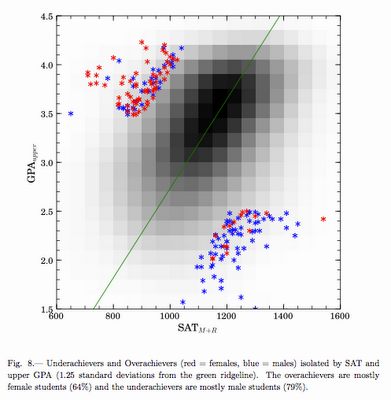Stephen Hsu, Technology Review Blog, April 03, 2010
Here is a draft of my paper with Jim Schombert on University of Oregon GPA and SAT statistics.
I posted previously on this research: Cognitive thresholds , The value of hard work. Introductory slides on g, SAT and all that.
Much of our data is available in the plots here.
Why did I get interested in this stuff? Obviously, I have a long-standing interest in psychometrics. In teaching 100 level courses, both Schombert and I have been flummoxed at the large population of students who have trouble with what we would consider elementary concepts (e.g., "scaling", or even "area" or "volume"!), yet seem to be successful in their chosen major ("I just can't seem to do these problems, but I need this class to graduate (fulfill a science requirement). I always get A's in English/History/Sociology/ ..."!) I'm sure every physics professor hears these things.
Because I invest a lot of time in helping students, e.g., solving lots of problems during office hours, I have a pretty close view of their learning abilities. I began to wonder how students could have trouble with these basic concepts ("Didn't you have to know that for the SAT?"), yet have high GPAs in their major. In talking to Jim, who is director of the General Science program, we realized the data was actually available to investigate these questions further.
Data Mining the University: College GPA Predictions from SAT ScoresFrom the Conclusions:
1. SATs predict upper GPA with correlations in the 0.35 -- 0.50 range.
2. Overachievers exist in most majors, with low SAT scores but very high GPAs. These overachievers are disproportionately female.
3. Underachievers exist in all majors, with high SAT scores but very low GPAs. These underachievers are disproportionately male.
4. Some majors, like math and physics, may exhibit a cognitive threshold -- mastery of the material is unlikely below an ability threshold (as measured by SAT-M), no matter how hard the student works.
Figure caption: Underachievers and Overachievers (red = females, blue = males) isolated by SAT and upper GPA (1.25 standard deviations from the green ridgeline). The overachievers are mostly female students (64%) and the underachievers are mostly male students (79%).
Read more

